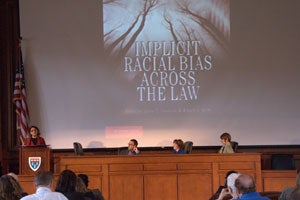An array of legal scholars, judges, practitioners and community leaders gathered at Harvard Law School on June 14 to discuss implicit racial bias, its presence in society and the law and new ideas about reducing its negative impact on disadvantaged groups.
The conference (program pdf), sponsored by the Charles Hamilton Houston Institute for Race & Justice, was organized to coincide with the publication of “Implicit Racial Bias Across the Law” (Cambridge University Press). The book, co-edited by Justin Levinson LL.M. ’04, professor of law at University of Hawaii, and Robert J. Smith ’07, assistant professor of law at the University of North Carolina, contains chapters written by legal academics, federal judges and practitioners who examine the impact of implicit bias on a variety of legal areas and contexts.
In introductory remarks, Levinson said that the book and conference came about as the result of “a social-sciences revolution that has occurred over the last two decades” involving research on the human brain, including studies that look at how cognitive processes are unconsciously formed and affected by biases and prejudices that can be ingrained from years of social learning and by negative stereotypes. But this new scientific evidence, he explained, has been slow to make its way into legal scholarship and the law.
Panelist Patricia Devine, a psychology professor at the University of Wisconsin, told conferees that not only can implicit bias now be better understood; it can be unlearned. She described anti-bias training methods that she and colleagues have used with students and their findings that implicit prejudices can be identified and broken through willful attention.
“If we are able to instantiate sufficient concern and help people become aware of their biases and actually teach them strategies that they could practice in their everyday lives,” she said, “it is encouraging to learn that people can start to break the prejudice habit.”
U.S. District Court Judge Mark Bennett (Northern District of Iowa) described his own efforts to deal with implicit bias in jurors.
During jury selection, he said, he talks extensively with potential jurors about explicit and implicit biases and provides many examples of each. “I talk about what it would be like if you were allowed to decide this case based on gut feelings rather than the evidence. I try to get them to realize that it’s kind of an easy habit to fall into, but you can’t really do that in federal court.”
He also has jurors sign a pledge that “they will not decide the issues in this case based on biases; this includes gut feelings, prejudices, stereotypes, personal likes or dislikes, sympathies, or generalizations.”
While judges may have latitude to reduce the influence of bias in criminal cases, HLS Professor of Practice Nancy Gertner described a much tougher task when it comes to discrimination cases. Gertner retired from the bench last fall after nearly 20 years as a U.S. District Court judge, and she told conferees that “discrimination law is moving in the direction of a paradigm that doesn’t remotely reflect the interesting research we’re talking about here.”
Part of the problem in discrimination law, she pointed out, is structural; the written law is based on what judges have to say when they grant summary judgment—and virtually all parties who move for summary judgment are defendant companies or organizations, not plaintiffs. She called the result “losers rules.”
“If case after case recites the facts that do not amount to discrimination, it should come as no surprise that the decision-makers at all levels have a hard time envisioning the facts that comprise discrimination.”
She predicted that the chances of success for plaintiffs bringing discrimination cases will only diminish—and that courts will be even further removed from the advances in social science.
Linda H. Krieger, a law professor at the University of Hawaii, echoed Gertner with an even broader pronouncement.
“For all the success in the academy, the implicit-science construct has made precious little headway in the courts, especially the federal courts, and it shows little sign of doing so anytime in the near future,” she said.
“Now and for the foreseeable future, the federal bench is likely to remain dominated by the right. For the most part, federal judges are hostile to discrimination cases and skeptical of social science. On the whole, federal judges are not showing themselves to be thinking about discrimination, either structurally or contextually.”
On a more optimistic note, G. Ben Cohen of The Justice Center in New Orleans said that he has worked directly with police departments and found that many chiefs are willing to take steps to reduce implicit bias among officers in their departments.
“It’s not sufficient to have the absence of intent to discriminate, which is what the legal standard is, but one needs to intend to not discriminate,” he said.
This new “intent” standard may not have weight in court, he acknowledged, “but police departments, I believe, are at liberty to hold their officers to an ‘intent to not discriminate’ standard, and that’s something I’m hoping to work with them on.”
He said the current controversy over New York City’s “stop and frisk” policy highlights the need for new standards.
“Millions of people are stopped and frisked every year in the U.S., 600,000 in New York City alone. So it’s a very a common occurrence that leads to dramatic disproportions in the criminal justice system.”
Video 1: Welcome by HLS Professor and CHHI Founding & Executive Director Charles Ogletree and Justin Levinson; Panel One: The Science: Exploring Implicit Bias in the Legal Context; Panel Two: Impacts of Implicit Bias Across the Law (requires QuickTime Player)
Video 2: Panel 3: Courtroom Implications of Implicit Bias (requires QuickTime Player)
Video 3: Implicit Bias and Criminal Justice (requires QuickTime Player)
Video 4: The Breadth of Implicit Bias in the Law (requires QuickTime Player)
Video 5: Implicit Bias and Organizations (requires QuickTime Player)
